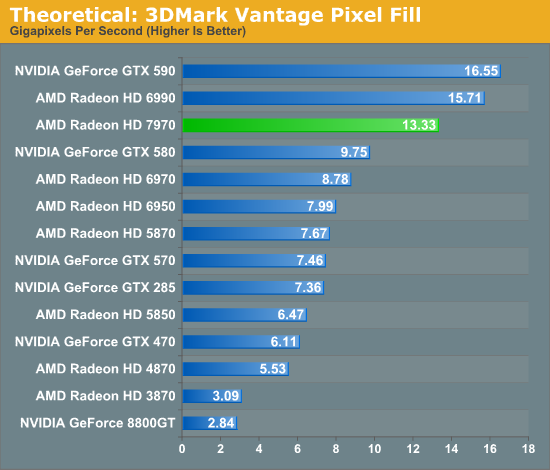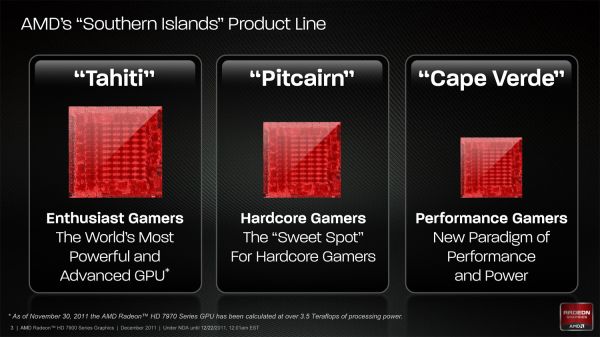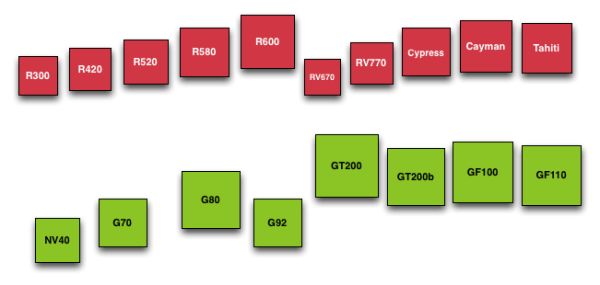AMD Radeon HD 7970 Review: 28nm And Graphics Core Next, Together As One
by Ryan Smith on December 22, 2011 12:00 AM EST- Posted in
- GPUs
- AMD
- Radeon
- ATI
- Radeon HD 7000
Building Tahiti & The Southern Islands
Now that we’ve had a chance to go over the basis of the Graphics Core Next architecture, let’s talk about the finished products.
Today AMD will be launching Tahiti, the first GPU of the Southern Islands family. Southern Islands will initially be composed of 3 GPUs: Tahiti, Pitcairn, and Cape Verde. Tahiti is the largest and most powerful member of the Southern Islands family, while Pitcairn and Cape Verde get progressively smaller. AMD has not yet announced the branding or launch dates for Pitcarn and Cape Verde, but it typically takes AMD around 6 months to launch a complete family. As such it’s reasonable to expect that all 3 GPUs will have launched by the end of June although there’s a good likelihood of it happening sooner than that.
All 3 GPUs are based on the GCN architecture, and as family members will have similar features while varying the number of functional units accordingly. Along with the architecture change Southern Islands brings with it a slew of additional features that we’ll get to in the following pages, including Partially Resident Texture (PRT) support, PCIe 3.0, FastHDMI, Direct3D 11.1, and AMD’s fixed-function H.264 encoder, the Video Codec Engine.
But today is all about Tahiti, so let’s get down to business.
As we quickly covered in our introduction, Tahiti is a 4.31B transistor GPU based on the GCN architecture and built on TSMC’s new 28nm High-K process. Due to TSMC canceling their 32nm process last year AMD has had to wait over 2 years for the next full node rather than taking advantage of the half-node process as they typically do, and as a result the jump from Cayman at 40nm to Tahiti at 28nm is much bigger than with past product launches. Whereas Cayman had 2.64B transistors and a die size of 389mm2, Tahiti has a whopping 63% more transistors than Cayman and yet it’s still smaller, coming in at a slightly more petite 365mm2.
At this point AMD hasn’t provided us with the typical board power values for 7970, but we do know that PowerTune is limited to 250W. In terms of design 7970 is clearly intended to work in similar environments as the 6970, in which case power consumption should be similar to the 6970.
Interestingly enough however we’re hearing that 7970 cards are proving to be very overclockable, which is a good sign for the state of TSMC’s 28nm process, and at the same time a bit distressing. Moore’s Law has continued to hold with respect to transistor density, but the power consumption benefits of using smaller nodes has continued to wane. Having a lot of overclocking headroom means that the 7970 has the potential to be much faster, but it also means that the 7970 (and 28nm GPUs in general) are going to be bottlenecked by power. In which case seeing as how we’re already approaching 300W with single-GPU video cards, the performance gains realized from future fabrication processes would be limited to the ever diminishing returns on power consumption improvements.
Diving deeper into Tahiti, as per the GCN architecture Tahiti’s 2048 SPs are organized into 32 Compute Units. Each of these CUs contains 4 texture units and 4 SIMD units, along with a scalar unit and the appropriate cache and registers. At the 7970’s core clock of 925MHz this puts Tahiti’s theoretical FP32 compute performance at 3.79TFLOPs, while its FP64 performance is ¼ that at 947GFLOPs. As GCN’s FP64 performance can be configured for 1/16, ¼, or ½ its FP32 performance it’s not clear at this time whether the 7970’s ¼ rate was a hardware design decision for Tahiti or a software cap that’s specific to the 7970. However as it’s obvious that Tahiti is destined to end up in a FireStream card we will no doubt find out soon enough.
Meanwhile the frontend/command processor for Tahiti is composed of 2 Asynchronous Command Engines (ACEs) and 2 geometry engines. Just as with Cayman each geometry engine can dispatch 1 triangle per clock, giving Tahiti the same theoretical 2 triangle/clock rate as Cayman. As we’ll see however, in practice Tahiti will be much faster than Cayman here due to efficiency improvements.
Looking beyond the frontend and shader cores, we’ve seen a very interesting reorganization of the rest of the GPU as opposed to Cayman. Keeping in mind that AMD’s diagrams are logical diagrams rather than physical diagrams, the fact that the ROPs on Tahiti are not located near the L2 cache and memory controllers in the diagram is not an error. The ROPs have in fact been partially decoupled from the L2 cache and memory controllers, which is also why there are 8 ROP partitions but only 6 memory controllers. Traditionally the ROPs, L2 cache, and memory controllers have all been tightly integrated as ROP operations are extremely bandwidth intensive, making this a very unusual design for AMD to use.
As it turns out, there’s a very good reason that AMD went this route. ROP operations are extremely bandwidth intensive, so much so that even when pairing up ROPs with memory controllers, the ROPs are often still starved of memory bandwidth. With Cayman AMD was not able to reach their peak theoretical ROP throughput even in synthetic tests, never mind in real-world usage. With Tahiti AMD would need to improve their ROP throughput one way or another to keep pace with future games, but because of the low efficiency of their existing ROPs they didn’t need to add any more ROP hardware, they merely needed to improve the efficiency of what they already had.
The solution to that was rather counter-intuitive: decouple the ROPs from the memory controllers. By servicing the ROPs through a crossbar AMD can hold the number of ROPs constant at 32 while increasing the width of the memory bus by 50%. The end result is that the same number of ROPs perform better by having access to the additional bandwidth they need.

The big question right now, and one we don’t have an answer to, is what were the tradeoffs for decoupling the ROPs? Clearly the crossbar design has improved ROP performance through the amount of memory bandwidth they can access, but did it impact anything else? The most obvious tradeoff here would be for potentially higher latency, but there may be other aspects that we haven’t realized yet.
On that note, let’s discuss the memory controllers quickly. Tahiti’s memory controllers aren’t significantly different from Cayman’s but there are more of them, 50% more in fact, forming a 384bit memory bus. AMD has long shied away from non-power of 2 memory busses, and indeed the last time they even had a memory bus bigger than 256bits was with the ill-fated 2900XT, but at this point in time AMD has already nearly reached the practical limits of GDDR5. AMD’s ROPs needed more memory bandwidth, but even more than that AMD needed more memory bandwidth to ensure Tahiti had competitive compute performance, and as such they had little choice but to widen their memory bus to 384bits wide by adding another 2 memory controllers.
It’s worth noting though that the addition of 2 more memory controllers also improves AMD’s cache situation. With 128KB of L2 cache being tied to each memory controller, the additional controllers gave AMD 768KB of L2 cache, rather than the 512KB that a 256bit memory bus would be paired with.














292 Comments
View All Comments
RussianSensation - Saturday, January 14, 2012 - link
BF3 is not a 2012 game.......Also, most of us have been gaming on our older cards. Who in the world who has a previous high-end card is going to drop $600 for BF3 alone? No thanks.
SSIV - Saturday, February 18, 2012 - link
Since there's a new driver out for there cards we can now regard these results with a grain of salt. Revise the benchmarks!DaOGGuru - Thursday, March 1, 2012 - link
I don't know why people keep forgeting about the 560ti 2win. Yes I said 2win = 2 560ti processors on one card. It still kills the 7970 numbers in BF3 by 20Fps. and is same price. It also beats the 580 and is cheaper. It's a single card with 50amp min. draw and it will smoke anything except 590 and the 6990...http://www.guru3d.com/article/evga-geforce-gtx-560...
CeriseCogburn - Thursday, March 8, 2012 - link
Oh, right, well this isn't an nvidia card review, so we won't hear from 50 posts about how some CF (would be SLI of course in this case) combo will whip the crap out of it in performance and price...You know ?
That's how it goes...
Usually the articel itself rages on about how some amd CF combo is really so much good and better and blah blah blah.... then the rpice perf, then the results - on and on and on ....
---
The angry ankle biters are swarmed up on the under red dog radeon side...
--
So you made a very good point, I'm just sorry it took 29 pages of reading to get to it, in it's glorious singularity.... you shouldn't strike out in independent thought like that it's dangerous.... not allowed unless the card being reviewed is an nvidia !!!!
DaOGGuru - Thursday, March 1, 2012 - link
oops... forgot to say look at previous post links BF3 rating for the 560ti 2win and compare to this charts 7970 fps. The 2win is pumping out @20 more FPS and is $50.00 - $100.00 cheaper than the 7970... lame.. ATi is still behind Nvidia but proud of it! lol They are just now catching up to Nvidia's tessellations and oh and AFTER they changed to a "cuda core copy" architecture and posting it as big news... Evga's older 560ti 2win still dusts it by 20FPS.. lame.DaOGGuru - Thursday, March 1, 2012 - link
sorry 10FPS not 20.. it's late.DaOGGuru - Thursday, March 1, 2012 - link
I don't get what's the hub-bub about the 7970.. sure it's the fastest single cpu;BUT, for $50.00-$100.00 less you can get the 560Ti 2win (dual cpu) that smokes the 7970 and the 2win PCB does have an SLI bridge and is cabapable of doing SLI to a second card but it's currently locked by Nvidia (see paragraph 3).Also, the 2win draws a min of only 50amps (way less than most sli configurations) 1. has a considerably lower noise dba, 2. runs cooler and with less power than almost all the high end cards and 3. will run 3 montiors in Nvidia 2D and 3D surround off a single card! 4.Will kill the GTX 580 by @33-23% (depending on review) 5. Will beat the 590 in some sample testing for TDP. And finally 6. will kill the 7970 by 10-20FPS in BF3 including by 10FPS in 1920x1200 4AA-16AF Ultra high mode. So, why have people forgotten the 2win? It's a singlecard, multi-GPU, full 3D/2D surround without a second card in SLI, $500.00USD beast !
OH and for those that say you can't SLI with a second 2win.... http://www.guru3d.com/article/evga-geforce-gtx-560... (this review states on conclusion page) > quote " you will have noticed there is a SLI connector on the PCB. Unfortunately you can not add a second card to go for quad-SLI mode. It's not a hardware limitation, yet a limitation set by NVIDIA, the GTX 560 Ti series is only allowed in 2-way SLI mode, which this card already is."
... So actually, the card is cabale 2card SLI but Nvidia for some (gosh aweful reason) won't let the dog off the chain. Probably because it will absolutely kill the need for a GTX580, 570, 560 Ti SLI configuration for ever!
Resources: (pay attention to BF3 FPS and compare to 7970 FPS in this article.)
http://www.anandtech.com/show/5048/evgas-geforce-g...
http://www.guru3d.com/article/evga-geforce-gtx-560...
Peace...
DaOGGuru - Thursday, March 1, 2012 - link
I don't get what's the hub-bub about the 7970.. sure it's the fastest single CPU; BUT, for $50.00-$100.00 less you can get the 560Ti 2win (dualCPU) that smokes the 7970 and the 2win PCB does have an SLI bridge and is capable of doing SLI to a second card but it's currently locked by Nvidia (see paragraph 3).Also, the 2win draws a min of only 50amps (way less than most sli configurations) 1. Has a considerably lower noise DBA, 2. runs cooler and with less power than almost all the high end cards and 3. Will run 3 monitors in Nvidia 2D and 3D surround off a single card! 4.Will kill the GTX 580 by @33-23% (depending on review) 5. Will beat the 590 in some sample testing for TDP. And finally 6. will kill the 7970 by 10-20FPS in BF3 including by 10FPS in 1920x1200 4AA-16AF Ultra high mode. So, why have people forgotten the 2win? It's a single card, multi-GPU, full 3D/2D surround without a second card in SLI, $500.00USD beast !
OH and for those that say you can't SLI with a second 2win.... http://www.guru3d.com/article/evga-geforce-gtx-560... (this review states on conclusion page) > quote " you will have noticed there is a SLI connector on the PCB. Unfortunately you cannot add a second card to go for quad-SLI mode. It's not a hardware limitation, yet a limitation set by NVIDIA, the GTX 560 Ti series is only allowed in 2-way SLI mode, which this card already is."
... So actually, the card is capable 2card SLI but Nvidia for some (gosh awful reason) won't let the dog off the chain. Probably because it will absolutely kill the need for a GTX580, 570, 560 Ti SLI configuration forever!
Resources: (pay attention to BF3 FPS and compare to 7970 FPS in this article.)
http://www.anandtech.com/show/5048/evgas-geforce-g...
http://www.guru3d.com/article/evga-geforce-gtx-560...
Peace...
CeriseCogburn - Thursday, March 8, 2012 - link
Ummm.... I read you, I see your frustration with all the posts - just refer to my one above there - you really should not be dissing the new amd like that - they like are 1st and uhh... nvidia is evil... so no comparisons like that are allowed when the fanboy side content is like 100 to 1....Now next nvidia card review you will notice a hundred posts on how this or that CF beats the nvidia in price perf and overall perf, etc, and it will be memorized and screamed far and wide...
Just like... your point "doesn't count", okay ?
It's best to ignore you GREEN fanboy types... ( yes even if you point out gigantic savings, or rather especially when you do...)
Thanks for waiting till page 30 - a wise choice.
CeriseCogburn - Sunday, March 11, 2012 - link
Southern Islands is a whole generation late. AMD promised us this SI in the last generation 6000 series. Then right before that prior release, they told us they had changed everything and 6000 was not Southern Islands anymore. LOLTalk about late - it's what two years late ?
Maybe it's three years....
In every case here, Nvidia beat them to the core architecture by two years. Now amd is merely late to the party crashing copycats....
That's late son, that's not original, that's not innovative, that's not superior, it's tag a long tu loo little sister style.